How To Choose The Right Art Glass For Your Projects
Stained glass sheets come in a huge array of colours, textures and transparencies. It can be hard to know which is best to use.
- Here you can find out about all the different types of sheets available for glassart.
- You can discover which sheets are best for each specific project and learn about the various ranges made by different manufacturers.
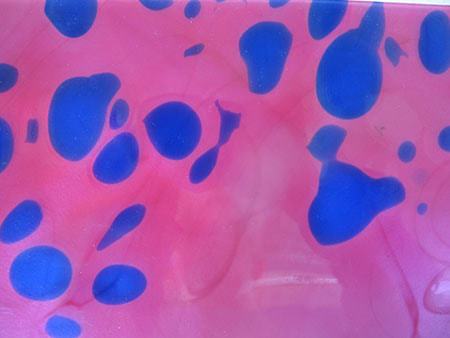
- Find out how to make stunning stained glass from the cheapest glass.
How? By layering it up together (plating).
Plating transforms even the most boring glass AND uses up all your ‘ugh‘ glass currently gathering dust on your shelves. See how to use glass to create limitless effects here
Jump down for ideas for cleaning dirty glass
Stained Glass Sheets
What are you looking for?
Light
If your main concern is maximising light and flooding your home with dancing colour, it’s Cathedral or German New Antique stained glass sheets you need. They are transparent and let light through.
Privacy
If you want to maintain privacy or don’t want too much light coming through, the best stained glass sheets for you are Opalescent or Semi-Opaque. That’s because light bounces off the surface and you can’t see through it directly.
Fusing
Fusing is a bit different. For this you will always need a special Fusible Glass, which can either be opaque or transparent.
To clear up a frequently asked question; you can use absolutely any sheets for making stained glassart, including Fusible sheets.
You can of course mix Opalescent and Cathedral in the same project with very exciting results.
Cutting Using the Grain of the Art Glass to Add Life to your Project
This video shows you how to use the glass grain to enhance the feeling you want from your panel.
In this example, I’m using green glass to cut the leaves of a flower. I want the grain to mimic a real leaf in nature as much as I can.
This video shows you how to cut the glass so the grain flows in the right direction. It also gives you some tips on how to avoid wasting glass.
Stained Glass Sheet Suppliers
Without question, it is always best to visit a supplier yourself and choose your own sheets if you can, as photos never, ever do the beauty of the individual sheets justice.
However, if there’s no stained glass suppliers near you, there are lots of stained glass suppliers who will ship glass to you.
It’s probably best to pick individually if you can, as there’s nothing worse than having too much of something that doesn’t excite you.
Cathedral and German New Antique Glass
Cathedral is an umbrella term used to describe a machine made glass (as opposed to Antique, which is mouth blown and consequently very beautiful and expensive).
It is transparent and comes in many textures and is usually, although not exclusively, made from a single colour.
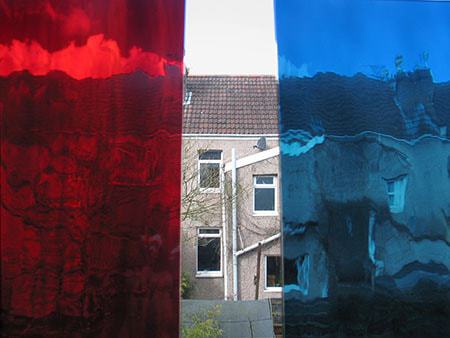
Cathedral sheets are especially good for beginners as they are uniform and very easy to cut.
There are many different manufacturers who make this type of stained glass, each with their own textures and specialities.
It might be worth having a look at Kokomo to see if you like their particular collections.
Spectrum make a huge range of cathedrals that are very reasonably priced, consistent and simple to cut. They also have unique textures to suit every design:
Waterglass (pictured above) with a distinctive gentle texture
Baroque (pictured at top) with dramatic three-dimensional coloured swirls and the Artique, that copies Antique blownglass with it’s irregularities
German New Antique is a little less dense than the Spectrum Artique and comes in a wide range of colours.
It has delightful striations that give it the appearance of being handmade. These are deliberate and there to be used to good effect.
Because it is machine made it has an even thickness, making it one of the easiest to cut.
Opalescent and Semi-Opaque Glass
Opalescent or Opal is glass that you can’t see through.
Semi-Opaque is usually a colour mixed with white or another colour, which allows you to partially see through it.
These sheets are perfect for projects that don’t need to be transparent – lamps, fire screens, wall art, and boxes.
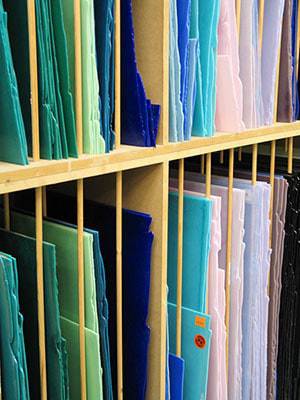
Opalescents can be amazing when put alongside Cathedrals, as the contrast between opacity and transparency seems to make the qualities of both glasses shout much louder.
Tiffany used a lot of this type of glass very, very skilfully in his stained glass windows and lampshades.
Uroboros produces some amazing premium handmade opalescents, with each sheet being an original work or art in itself.
If you can’t afford this, Spectrum’s machine-made range is excellent, covering single colour Opalescents to wispy and streaky Semi-Opaques (pictured above) that are shouting out to be used creatively.
Iridized and pearlescent sheets
These have a coating of metallic oxide bonded on to the surface, which make them shimmer and change colour depending on the viewing angle.
These sheets can lift a stained glass artwork, but are best not over-used as they can dominate a design.
Fusible Glass
The term Fusible Glass describes a range that has been specifically manufactured for compatibility so that it can successfully ‘fuse’ with other sheets during firing.
The measurement of this is the Coefficient of Expansion (CoE). If your glass is not compatible – or fusible – your stained glassart will contain stress and crack during or after firing.
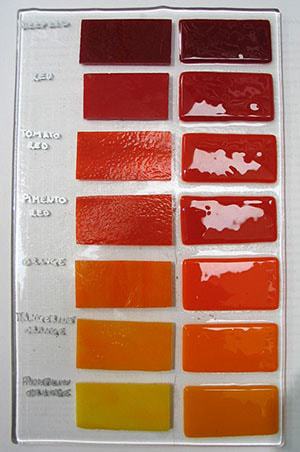
Bullseye
Perhaps the most successful manufacturers of fusible glass are Bullseye Glass. Their glass has a CoE of 90, and is compatible with both dichroic and Uroboros sheets.
Each sheet is hand rolled and they have stringent compatibility checks in place.
Depending on your project, you can choose either opaque or transparent.
Before you choose, think about whether you want the light bouncing off (reflecting) or shining through (transmitting). And then choose away – what Bullseye don’t make isn’t worth having – you can have single colours, streakys, iridescent, textured, chopsticks, streamers… I could go on!
If you use this for stained rather than fused glass, the single-rolled version – as opposed to double-rolled – is cheaper and just as wonderful.
Spectrum
Spectrum also does a Fusible Glass range called System 96.
They don’t have the same number of variations as Bullseye, but they are expanding all the time. System 96 sheets are very reliable, easy to cut and visually interesting.
It’s also cheaper than Bullseye. Only use System 96 for fusing, as the other Spectrum glass is not compatible.
Cleaning Dirty Old Sheets of Stained Glass
Some of us are lucky enough to get our hands on old stained glass sheets. Second-hand glass or old antique sheets that have been lying around a while can be pretty grimy and hard to clean. So how do you clean these dirty sheets of stained glass?
Ideas For Cleaning Grimy Stained Glass Sheets
There are many answers to this problem. Along with my own ideas, I’ve seen many over the years that I haven’t yet tried. Below you’ll see a list of all the suggestions I’ve gathered together in one place*. I’m sure one of these solutions will be the answer to your dirty glass problem!
It’s worth noting that I’d always soak the stained glass first, whatever method you choose. Also, be aware that the surface of the glass will scratch if a rough abrasive is used, so start with the less ‘scratchy’ ideas first and move up if needs be.
- Spray with vinegar. Let it set then spray again and clean off.
- Dawn soap, vinegar, and hot water.
- Caustic soda bath for really stubborn dirt (be very careful with this as its corrosive – wear gloves, use a mask and do in a ventilated space). Do not inhale it.
- Whiting powder method (one of my favourites):
Don’t use this method if any of the panels are painted with semi-permanent artwork as this may rub it off.
Whiting is a little abrasive so be mindful how hard you scrub.- Lay the glass sheet flat on your work surface
- Sift a thin, covering layer of whiting all over the panel
- Take a spray bottle of water and mist it over the whiting until you make a paste
- Let it dry, and then take a natural tampico bristle brush (NOT nylon), and start scrubbing. The abrasiveness of the whiting will polish off the grime
- Make a paste of baking soda. Then you can add vinegar and let it bubble before scrubbing and washing off.
- Spray with diluted Simple Green. Let it sit for a bit then sprinkle with sawdust and scrub it up with a plastic scrubbing brush.
OR: clean in a warm bath of Simple Green. Then use a stainless steel wire brush to gently clean it off. Additionally, you can use a small amount of comet cleanser on the brush for the tough spots.
I’d use this one with caution as it’s the most abrasive – you could try a toothbrush rather than a wire brush. - Make a mix of soapy ammonia – e.g. Sudsy Ammonia – mixed with water & detergent. Scrub in little circles with a toothbrush.
- Apply a degreaser then scrub and polish. You can get citrus, non-chemical degreasers that are less dominant. They may not work as well as a regular degreaser but are a lot nicer to work with and far less smelly.
- Mr. Clean Magic Eraser plus elbow grease! This is especially good for black patina stains.
- Distilled water and dish soap – e.g. Seventh Generation Natural Dish Liquid. Use a damp soft cloth soaked in the solution to gently clean. You can use a Q-tip cotton bud to get into ridges and corners.
This is unlikely to get stubborn grime off but is a neutral and safe suggestion for more delicate or precious glass.
*Thanks to you if you recognise your contribution 🙂
Helpful Resources
You might find this 3.5 minute video helpful for identifying the different types of stained glass sheets available. It always helps to see them for real:
Here are the company’s websites if you’d like to see the full range of sheets they sell.

Tips for Working with Textured Stained Glass
There are 3 different ways to work out how much glass you need here.
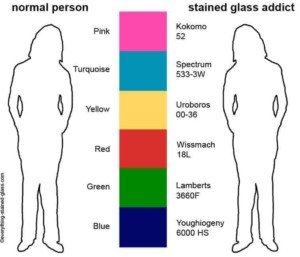

I recently purchased a couple of vintage stained glass lamp shades. What are the best cleaning products to use so I don’t destroy the solder or the patina? One of them must have come from a smoker’s home because the film on it is thick and sticky.
I have lots of suggestions for cleaning dirty glass here Michelle:
https://everythingstainedglass.com/stained-glass-sheets
Scroll down to the relevant section.
Good luck 🙂
I spray with a mixture of 50% vinegar diluted to 25-30% and a tablespoon of Dawn. It goes in the dishwasher and air dries.
Thanks for this Barb, very useful
Hi Milly,
I have done your wonderful course – it has helped me immensely! Thank you for your regular newsletter with all these excellent tips and advice.
I was wondering if there is any way of knowing whether a piece of glass is fusible or non-fusible without firing it? I have several pieces that no longer have their stickers on them, and don’t want to try and fire a piece that is non-fusible.
If there isn’t a way of testing the glass, I guess I will be doing more copper foiling and lead light work!
Many thanks!
Theresa
I’m so glad you found my course helpful Theresa.
No, there’s no way apart from testing in the kiln. And if you don’t know the type of glass you also won’t know the recommended firing schedule for the glass either. I hope that hasn’t ruined your day 😉
For cleaning glass, as well as vinegar and detergent in warm water initially, I use isopropyl alcohol as a final wipe over when I’m preparing a piece before painting to get the surface completely clean.
Oh yes, I use this too Vicky, thanks so much for adding it, very helpful.
I use windshield washer fluid. After all it is made to remove grease, dirt and grime! I pour it into a small spray bottle that resides on my bench. It’s also excellent for spot removing flux. Very inexpensive and a gallon jug lasts a very long time!
Thanks Patti, that’s a fantastic tip for everyone 🙂
Hi all, would like to add some more details on using caustic soda, or better sodium hydroxide, an alkali salt. Indeed follow the safety rules which are by law typically written on the package or via a QR code on the package. Search on Google if you’re uncertain!
As I only use and reuse glass from early 1900’s windows, (sometimes it looks like this has been stored in a henhouse since WW-1….) to restore or make new windows, my best results I get:
Use 10 liter good quality plastic buckets, fill with a collection of glass pieces, about half of the bucket, add drain cleaner caustic soda (quite a bit, volume by experience), fill up the bucket with 60 degrees C water, carefully lift and place the bucket outdoor for 36-48 hours, then empty (water and dirt) the bucket into the sewer and flush a few times with cold water (I use rain water). Flush water into the sewage system.
Result: very clean and reusable glass (and a clean sewage water system…) not too much effort at all!
If questions please let me know!
Wow Willem, that’s so helpful. Sounds like a recipe for clean glass success. Thank you 🙂
Great info…thanks..but does anyone know how to laminate dichroic to other glass to use in stained glass without fusing?
My favoured pre-treatment, before using more serious cleaning methods is, firstly to use a large soft dusting brush to remove any loose surface debris. Then to use a steam cleaner filled with distilled or de-ionised water, along with a natural bristle brush for scrubbing. The glass should be supported in an upright position but at an angle to allow water run off. This will remove most all of the surface grime. I then use a 70v/50v isopropyl alcohol / distilled water mix on a cotton rag as a final clean. If the glass still requires further cleaning then I use the whiting method above. Obviously, painted surfaces have to be dealt with in a completely different way.
Wow that’s a really useful idea, thanks for sharing it Syd. I’ve never thought of a steam cleaner before.
I am very pleased to have found your site which is very interesting and informative. However I have a question about using up the scraps of tatra glass I have been using to make stained glass windows for my lovely Victorian type greenhouse based on the Tom Fruin style. I was wondering if I could make Frit out of the scraps and use in on the larger scrap pieces to make Christmas decorations etc. I don’t seem to be able to find out the Coe of tatra glass or if it woukd be suitable for fusing. Can you help?
You can fuse any glass to itself Elizabeth. You can make frit from Tatra (or any glass) by heating it in a kiln and thermally shocking it by throwing it into a bucket (galvanised steel) of cold water. Use care and protective clothing/glasses.
You’d have to test different colours together to see if they a. fuse okay and b. look nice! Glass not specifically made for fusing can devitrify far more easily that glass made for fusing.
Alternatively, have a look at this page for how to use those scraps up:
https://everythingstainedglass.com/scrap-glass
Good luck either way.
My favourite glass cleaner is acetone. Wear good rubber gloves. Please be careful as it dissolves plastics.
Give a the glass a pre-wash with warm detergent water for maximum effectiveness and use the acetone to give a brilliant sparkle.
I am resealing some thirty year old double glazed units. The seals perish in part allowing condensation inside. After removing the protective tape, masking tape can you believe? I cover the old seal with gutter sealant, using old cooking oil and straight edge for a smooth finish, cover with 1mm rubber strips, then finish with aluminium tape. I will clean the glass as above before reinstalling them to prevent damage to the uPVC frames.
If wooden window frames are properly looked after, the few I have are undercoated with bitumen primer, they should I hear last for a hundred and fifty years.
That’s extremely useful information to share with us Danny, thanks so much. Your experience is precious.
Hi, thanks for all your helpful and encouraging tips. I have a few different vintage glass windows I bought to fix, each one has a different broken textured piece.
I’m struggling to find matches, which I should have expected. Will it work OK to replace with modern textures of the same depth, or is there a supplier which makes those clear crinkly and mossy glass types? Thanks, Rebecca
Colour registers more loudly over texture Rebecca, so if you can match the colour (including depth of colour) then you’re past the hardest hurdle. There are lots of textures available, have you had a look at Oceanside’s online catalogue here? https://oceansidecompatible.com/pages/product-catalog
Good luck 🙂
Thank you for sharing your knowledge so freely. It really helps to have an expert to answer questions and demonstrate techniques. I have a question for you. What kind of glass would work best on a fire screen? Do you have to use tempered glass?
Patterned Opaques as there’s no or little light behind. Fire screens are only decorative, you have to remove them when the fire is going. Apologies if you already knew this… just don’t want anyone to try it!
I hope that helps Brenda.
I, too, love everything you share with us and so generously. I am working on the course and loving it but slowly as I have to fit it in the rest of life but it always gives me something to expect and anticipate with joy. I see some folks work in mosaics so my question is this…..I have been trying to add mosaic glass to my stained glass pieces. I have tried a few ways but does anyone know if it is better to add the mosaic pieces after you cut the piece or after you have soldered in place? I am not sure what is working better…]
Any help is greatly appreciated.
I’m happy you’re finding my online class enjoyable Geri, thanks.
I’m having a bit of trouble visualising what you’re asking. If you’re incorporating the two in the same panel, I would suggest before soldering. Cut the base glass for the mosaic when you cut the rest of the glass, then do mosaic, leaving a clean untouched bit around the edge for the foil or lead. Then assemble as normal. I hope I’ve got the right end of the stick!
Spectrum glass iwas bought out and now produced in Mecico
Thanks for the nudge Der, I need to update this page for sure! Oceanside now make what was Spectrum glass, as you say.
Can you please tell me the glass that will replicate that used on those vintage Japanese glass wind chimes?? I can’t find the wind chimes for sale anywhere so I am intent on making my own. Today’s chimes don’t sound like the originals, so I thought maybe it’s the type of glass they used to use?
Thank you!
What an interesting question April. And one I don’t know the answer to, sorry 🙁 Does anyone else have any ideas? TIA
I use my scrap glass, cut then into rectangles of leave them their odd shapes, drill holes and make my own. They all have their own “tinkle”
Thank you for sharing your idea Susan, I appreciate it.
Hi Milly,
I so love all of your information!! I print all and save it in a big file folder for quick information!!
I do mostly mosaics. I am saving up to purchase stained glass supplies and tools!! I love learning a ton before I try! This article is WONDERFUL for me! I do have 1 question… is ALL stained glass usable for outdoor projects?? I want to try a wooden Totem with stained glass inlays!
Loved reading this, thanks Leslie 🙂 I can see you with your file! Yes, all glass is usable for outside. It’s all the same for ‘cold’ techniques – stained glass and mosaic. The only time you have to be discerning is when using ‘hot’ techniques in a kiln – e.g. fusing glass together, when the glass has to be compatible.
Hey Milly! You are amazing!!! I was just wondering where you buy glass in the UK? do you have any preference or can refer me and you can get a percentage?? Worth asking!
I don’t have any affiliate schemes with any Stained Glass suppliers but thanks for thinking of me, very kind Jen 🙂 I live near Creative Glass in Bristol and go there as it’s always best to see the glass if you can.
There is a shop called Lead and Light which has loads of glass and reasonably priced. They also have an online shop.
You boost my confidence in my quest to get better at the pieces I do. Thank you
Oh Mary, what a lovely thing to read, thanks so much 🙂
A turkey baster works well for removing water from a grinder.
It is less expensive than the hydrolic pump.
Good thinking David, thanks for the tip.
Would love to receive the newsletter…I am a woodworker…and would like to explore stained glass in my work…
Hello Jett, what an exciting combination, I’m jealous! Never did get the hang of wood. I’ve signed you up to my newsletter so you should receive that soon. I hope you love stained glass!
I love, so much, all the notions you give us in the world of stained glass
That’s a lovely comment to read, thank you Sylvie. I love to think that my work is helpful and inspiring 🙂
“Everything Stained Glass” offers the most comprehensive tutorials on working with glass I have been able to find.
This website will help you with the fundamentals of stained glass construction and beyond.
You’re limited only by your imagination.
Aw sweet Birney, thanks so much for your vote of confidence! Milly
Thank you you are so intune with so many ways of Cleaning..I am in the process Cleaning RealTiffany Drapery glass bought from the OriginaI Stain glass Studio in Wisconsin. Your ideas will help insure the safety of these full sheets. Continued success and will be following you more!♡
Do you have an address or cataloge
Hi Kathy, thanks for your enquiry. I don’t sell products, I have a range of online stained glass courses. Sorry I can’t be more help this time.
Where can I buy glass for lead glass I live in Humans drop in the Eastern CAPE nearest town Port Elizabeth but the art studio’s don’t sell glass
Thanks for your question Moreen. I’m afraid I don’t know who might supply glass in South Africa – I’m in the UK. You could try emailing other stained glass artists in SA and see where they get their glass – for example this one: https://www.classyglass.co.za/
Is there anyone out there in South Africa that can help?
Try Delphi Stained Glass in Lansing, Michigan, USA.
I’ think they ship internationally.
Good luck.
Thanks for taking the time to help out Birney, I appreciate that 🙂